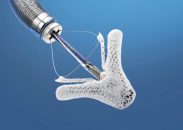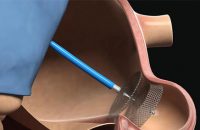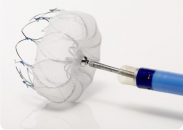RE-DUAL PCI outcomes have been published by the New England Journal of Medicine along with their presentation at ESC 2017. The traditional triple anti-thrombotic scheme with dual antiplatelet therapy and warfarin for patients with atrial fibrillation undergoing coronary angioplasty seems to have been left behind. This new study showed that the combination of dabigatran with a P2Y12…
Diastolic Dysfunction: Shall We Begin to Assess It?
Courtesy of Dr. Carlos Fava. The association between diastolic dysfunction (DD) and aortic insufficiency (AI) after transcatheter aortic valve replacement (TAVR) has not been studied yet, but the presence of aortic regurgitation has proved to be associated with worse outcomes. A total of 144 out of 195 patients who underwent TAVR with balloon-expandable SAPIENS or SAPIENS XT…
Closing off the Appendage While Performing Cardiac Surgery Results in a Reduction in Risk of Embolic Stroke
Closing off the left appendage as an add-on procedure while performing other cardiac surgery in patients with atrial fibrillation resulted in a reduction in risk of embolic stroke of nearly 40% over 12 months, according to an analysis carried out on the Society of Thoracic Surgeons (STS) database. Patients who had surgical appendage occlusion had…
MitraClip: Impact of Sinus Rhythm and Heart Rate
Courtesy of Dr. Carlos Fava. Atrial fibrillation (AF) and fast heart rate (>70 lpm) have been shown to increase the risk of mitral valve repair surgery. The MitraClip has shown benefits in high risk patients, but its relation to abnormal heart rhythm has not yet been established. 760 patients were analyzed; 315 (52.4%) presented…
Apixaban: An Alternative for Patients with Atrial Fibrillation Undergoing TAVR?
Courtesy of Dr. Carlos Fava. The prevalence of atrial fibrillation in patients undergoing transcatheter aortic valve replacement (TAVR) is high (32.9%, according to the PARTNER Trial, and 46.8%, according to the CoreValve High-Risk Study), and is associated with thromboembolic events (as in all other populations). Apixaban has shown to benefit patients with nonvalvular atrial fibrillation,…
Anticoagulated Patients with Atrial Fibrillation Undergoing Angioplasty: How to Treat Them
In patients with atrial fibrillation undergoing coronary angioplasty with stents, standard anticoagulation with vitamin K antagonists plus dual antiplatelet therapy with a P2Y12 inhibitor and aspirin reduces the risk of stent thrombosis and stroke, but increases the risk of bleeding. The effectiveness and safety of anticoagulation with rivaroxaban plus one or two antiplatelet agents…
Left Atrial Appendage Closure: Effective to Reduce Risk of Stroke?
Original Title: Effectiveness of Left Atrial Appendage Exclusion Procedures to Reduce the Risk of Stroke: A Systematic Review of the Evidence. Reference: North Noelck et al. Circ Cardiovasc Qual Outcomes. July 2016. Published ahead of print. Atrial fibrillation is an important cause of stroke. Oral anticoagulation reduces the risk of stroke but, on the…
Atrial Fibrillation: Important Impact on TAVI
Original Title: Atrial Fibrillation Is Associated With Increased Mortality in Patients Undergoing Transcatheter Aortic Valve Replacement: Insights From the Placement of Aortic Transcatheter Valve (PARTNER) Trial. Reference: Angelo B. Biviano et al. Circ Cardiovasc Interv. 2016 Jan;9(1):e002766. Courtesy of Dr. Carlos Fava. The conversion to atrial fibrillation (AF) in the context of transcatheter aortic valve replacement…
Left Atrial Appendage Closure with Watchman Device. 5 Year Outcomes
Original Title: Percutaneous Left Atrial Appendage Closure with the Watchman Device Long-Term Results Up to 5 Years. Reference: Wiebe J, Franke J, Lehn K et al. JACC Cardiovascular Interventions Vol. 8, NO. 15, 2015 Doi: 10.1016/j.jcin.2015.07.040 Courtesy of Dr. Agustín Vecchia. Atrial fibrillation (AF) is one of the most predominant arrhythmias and is associated to cardioembolic…
Cost-Effectiveness of Left Atrial Appendage Closure and the New Anticoagulants vs. Warfarin in Atrial Fibrillation
Original Title: Time to Cost-Effectiveness Following Stroke Reduction Strategies in AF Warfarin vs. NOACs vs. LAA Closure. Reference: Vivek Y. Reddy et al. J Am Coll Cardiol. 2015;66(24):2728-2739. Left atrial appendage closure and the new anticoagulants (NOACs) have emerged as safe and effective alternatives to warfarin for stroke in patients with non-valvular atrial fibrillation. This analysis…
- 1
- 2









